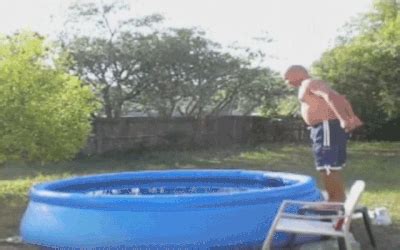
A yellow Labrador puppy’s persistent, albeit clumsy, attempts to float in a swimming pool have captivated audiences online, showcasing the dog’s unwavering determination despite repeatedly sinking.
A video of the unnamed pup’s comical struggle, shared on social media, has garnered widespread attention, highlighting the breed’s known affinity for water and their tenacious spirit. The footage depicts the young Labrador repeatedly trying to stay afloat, paddling furiously with its front paws while its hind legs sink, leading to a series of amusing underwater plunges. Despite the lack of success, the dog continues its efforts with unwavering enthusiasm, embodying the classic Labrador retriever traits of eagerness and perseverance.
“Yellow Labs are just the best,” the original poster captioned the video, perfectly capturing the sentiment shared by many viewers who found the pup’s efforts endearing and relatable. The video serves as a lighthearted reminder of the joy and amusement that pets bring to people’s lives.
The Internet Reacts to the Lab’s Aquatic Antics
The video’s virality speaks to the universal appeal of animal antics and the internet’s fondness for heartwarming content. Social media platforms buzzed with comments ranging from humorous observations about the pup’s technique to expressions of admiration for its unwavering spirit.
“That dog is going places. Maybe not floating places, but places nonetheless,” one user quipped, capturing the general sentiment of amusement and encouragement. Others shared personal anecdotes about their own Labs and their experiences with water, further amplifying the sense of connection and shared experience.
The video also sparked discussions about responsible pet ownership, with many users emphasizing the importance of teaching dogs how to swim safely and providing proper supervision around water. This underscores the need to balance the enjoyment of pets’ natural instincts with ensuring their safety and well-being.
Labradors and Water: A Breed Built for Swimming (Usually)
Labrador Retrievers are renowned for their love of water, a trait deeply ingrained in their history and physical characteristics. Originally bred in Newfoundland, Canada, to assist fishermen, these dogs were tasked with retrieving nets and hauling ropes through icy waters. This demanding work required a strong, athletic build, a water-resistant coat, and an innate ability to swim.
The breed’s physical attributes reflect its aquatic heritage. Labradors possess a dense, double-layered coat that provides insulation and buoyancy in cold water. Their webbed feet act as natural paddles, enhancing their swimming efficiency. Furthermore, their powerful tails serve as rudders, allowing them to steer and maintain balance in the water.
While most Labradors take to swimming naturally, individual dogs may vary in their abilities and confidence levels. Factors such as age, physical condition, and prior experience can influence a dog’s comfort in the water. In some cases, puppies may need gradual introduction and positive reinforcement to develop their swimming skills.
The featured puppy’s struggles, while humorous, highlight the importance of proper swimming instruction and supervision. While Labradors are generally strong swimmers, they are not immune to accidents. Teaching a dog how to enter and exit the pool safely, as well as how to float and conserve energy, can significantly reduce the risk of drowning.
Experts Weigh In: Understanding Canine Swimming
Veterinarians and dog trainers emphasize the importance of understanding canine swimming mechanics and providing appropriate support for dogs learning to swim.
“Not all dogs are natural swimmers, even breeds that are known for their love of water,” explains Dr. Emily Carter, a veterinarian specializing in canine sports medicine. “It’s crucial to introduce dogs to water gradually and observe their behavior. If a dog is panicking or struggling, it’s important to remove them from the water immediately and try again later with a more positive approach.”
Dog trainers recommend using positive reinforcement techniques, such as treats and praise, to encourage dogs to swim. They also suggest using a dog life vest for added safety, especially for puppies or dogs with limited swimming experience.
“A life vest can provide extra buoyancy and help a dog maintain a horizontal position in the water,” says Sarah Johnson, a certified dog trainer. “This can be particularly helpful for dogs that are just learning to swim or those that have a tendency to sink their hindquarters.”
Johnson also emphasizes the importance of teaching dogs how to swim in a controlled environment, such as a shallow pool or a calm lake, before venturing into deeper water. This allows dogs to gain confidence and develop their swimming skills without feeling overwhelmed.
The Broader Context: Viral Animal Videos and Their Impact
The Labrador puppy’s viral video is just one example of the internet’s enduring fascination with animal content. From cats playing the piano to dogs riding skateboards, animal videos consistently generate high levels of engagement and shareability on social media.
These videos often serve as a source of lighthearted entertainment, providing a momentary escape from the stresses of daily life. They can also foster a sense of connection and community among animal lovers, who share their experiences and appreciation for the unique qualities of their pets.
However, the viral nature of animal videos also raises ethical considerations. It is important to ensure that the animals featured in these videos are treated humanely and that their well-being is not compromised for the sake of entertainment. This includes avoiding situations that could cause animals stress, fear, or physical harm.
Furthermore, it is important to be mindful of the potential for animal videos to perpetuate harmful stereotypes or misconceptions about certain breeds or species. For example, videos that depict dogs engaging in aggressive behavior can reinforce negative stereotypes about certain breeds, leading to discrimination and prejudice.
Lessons Learned: Perseverance, Joy, and Responsible Pet Ownership
The Labrador puppy’s story offers several valuable lessons. First and foremost, it demonstrates the power of perseverance. Despite repeatedly sinking, the pup never gives up on its goal of floating, embodying a spirit of determination that is both inspiring and endearing.
Secondly, the video serves as a reminder of the simple joys that pets bring to our lives. Their playful antics, unconditional love, and unwavering loyalty can provide a much-needed sense of companionship and emotional support.
Finally, the video underscores the importance of responsible pet ownership. This includes providing pets with proper care, training, and supervision, as well as ensuring their safety and well-being. By understanding the needs of our pets and providing them with the resources they need to thrive, we can create a mutually beneficial relationship that enriches both their lives and our own.
Extending the Narrative: Labrador Breed Information and Care
The Labrador Retriever, consistently ranked among the most popular dog breeds worldwide, boasts a rich history and a diverse range of talents. Originating from Newfoundland, Canada, the breed was initially developed to assist fishermen in retrieving nets and hauling lines through frigid waters. Their intelligence, trainability, and gentle temperament quickly made them indispensable working companions.
Over time, Labradors transitioned from working dogs to beloved family pets. Their friendly and outgoing personalities, combined with their eagerness to please, make them ideal companions for people of all ages. They are particularly well-suited for families with children, as they are known for their patience and tolerance.
In addition to their roles as family pets, Labradors continue to excel in various working roles. They are commonly used as guide dogs for the blind, assistance dogs for people with disabilities, and search and rescue dogs. Their keen sense of smell and unwavering focus make them invaluable assets in these demanding professions.
Caring for a Labrador Retriever
Labradors are relatively easy to care for, but they do require regular exercise, mental stimulation, and proper nutrition to thrive. They are active dogs that need at least an hour of exercise per day, which can include walks, runs, swims, or games of fetch. Without sufficient exercise, they can become bored and destructive.
Mental stimulation is also crucial for Labradors. They are intelligent dogs that need to be challenged and engaged. Puzzle toys, obedience training, and interactive games can help keep their minds sharp and prevent boredom.
Labradors have a tendency to overeat, so it is important to feed them a balanced diet and monitor their weight. Obesity can lead to a variety of health problems, including joint pain, diabetes, and heart disease.
Regular grooming is also essential for Labradors. Their double-layered coat sheds moderately throughout the year, with heavier shedding periods in the spring and fall. Brushing them several times a week can help remove loose hair and prevent matting.
Common Health Concerns in Labradors
While Labradors are generally healthy dogs, they are prone to certain health conditions. These include:
- Hip and elbow dysplasia: These are common joint conditions that can cause pain and lameness.
- Progressive retinal atrophy (PRA): This is a genetic eye disease that can lead to blindness.
- Exercise-induced collapse (EIC): This is a genetic condition that can cause dogs to collapse after strenuous exercise.
- Bloat (gastric dilatation-volvulus): This is a life-threatening condition that occurs when the stomach fills with gas and twists.
Responsible breeders screen their dogs for these health conditions to reduce the risk of them being passed on to their offspring.
The Future of Viral Animal Videos
The internet’s fascination with animal videos shows no signs of waning. As social media platforms continue to evolve, new opportunities for sharing and engaging with animal content will undoubtedly emerge.
Virtual reality (VR) and augmented reality (AR) technologies could potentially revolutionize the way we experience animal videos. Imagine being able to virtually interact with a Labrador puppy swimming in a pool, or observing a pride of lions in their natural habitat from the comfort of your own home.
Artificial intelligence (AI) could also play a role in the future of animal videos. AI algorithms could be used to analyze animal behavior, identify patterns, and create personalized content that is tailored to individual viewers’ preferences.
However, it is important to ensure that these technological advancements are used ethically and responsibly. The well-being of animals should always be the top priority, and their rights should be protected.
Conclusion: A Heartwarming Tale of Determination
The Labrador puppy’s hilarious pool struggle is a testament to the breed’s unwavering spirit and its enduring appeal. The video serves as a reminder of the joy and amusement that pets bring to our lives, as well as the importance of responsible pet ownership. As we continue to share and engage with animal content online, it is crucial to do so in a way that is both entertaining and ethical, ensuring that the well-being of animals is always at the forefront. The determination of this little Lab reminds us that even when we sink, getting back up and trying again is what truly matters. It’s a lesson humans can learn from our four-legged friends.
Frequently Asked Questions (FAQ)
-
Is the Labrador puppy okay? Yes, according to the information available and inferences made from the pup being encouraged to continue the act by the owner, the Labrador puppy appears to be unharmed during its swimming attempts. The video’s humor stems from the puppy’s persistent efforts, not from any indication of distress or injury. However, experts recommend proper swimming supervision and instruction to ensure their safety.
-
Why is the puppy struggling to float? While Labradors are generally good swimmers, several factors could contribute to the puppy’s struggle. It may be young and still developing its swimming skills, or it may not yet have the muscle strength and coordination needed to stay afloat easily. Additionally, some individual dogs may have a more difficult time learning to swim than others.
-
How can I teach my dog to swim safely? Introduce your dog to water gradually and positively. Start with shallow water and use treats and praise to encourage them. Support their body and let them get used to the feeling of being in the water. Never force your dog to swim if they are afraid. Consider using a dog life vest for added safety, especially for puppies or dogs with limited swimming experience. Teach them how to enter and exit the pool safely.
-
Are all Labrador Retrievers good swimmers? While Labradors are known for their love of water and are generally strong swimmers, not all individuals are naturally gifted swimmers. Factors such as age, physical condition, and prior experience can influence a dog’s comfort and ability in the water. It’s important to assess each dog individually and provide appropriate support and instruction.
-
What are the benefits of swimming for dogs? Swimming is a great form of exercise for dogs, providing a low-impact workout that is easy on the joints. It can also help improve cardiovascular health, muscle strength, and endurance. Additionally, swimming can be a fun and stimulating activity for dogs, helping to reduce boredom and anxiety.









